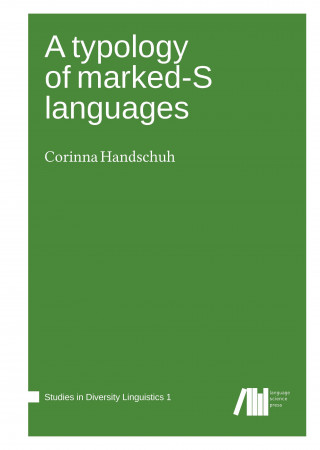
Kód: 12826103
A typology of marked-S languages
Autor Corinna Handschuh
Case-systems all over the world exhibit striking similarities. In most languages intransitive subjects (S) receives less overt marking than one of the two transitive arguments (agent-like A or patient-like P); the other one of the ... celý popis
- Jazyk:
 Angličtina
Angličtina - Vazba: Pevná
- Počet stran: 280
Nakladatelství: Language Science Press, 2015
- Více informací o knize

Mohlo by se vám také líbit
-

Messages
298 Kč -

El Muro: Conquistate a Ti y Luego El Mundo = the Wall
428 Kč -

Nie seplenie
153 Kč
Darujte tuto knihu ještě dnes
- Objednejte knihu a zvolte Zaslat jako dárek.
- Obratem obdržíte darovací poukaz na knihu, který můžete ihned předat obdarovanému.
- Knihu zašleme na adresu obdarovaného, o nic se nestaráte.
Více informací o knize A typology of marked-S languages
Nákupem získáte 80 bodů
 Anotace knihy
Anotace knihy
Case-systems all over the world exhibit striking similarities. In most languages intransitive subjects (S) receives less overt marking than one of the two transitive arguments (agent-like A or patient-like P); the other one of these two arguments is usually encoded by the same form as S. In some languages the amount of overt marking is identical between S, A, and P. But hardly ever does the S argument receive more overt marking than A or P. Yet there are some languages that do not follow this general pattern. This book is about those languages that behave differently, the marked-S languages. Marked-S languages are well-known to be found in East Africa, where they occur in two different language families, Afro-Asiatic and Nilo-Saharan. They can also be found in North-Western America and the Pacific region. This book is the first investigation of marked S-languages that treats the phenomenon on a global scale. The study examines the functional distribution of the two main case-forms, the form used for S (S-case) and the case-form of the transitive argument which receives less marking (the zero-case). It offers a very fine-grained perspective considering a wide range of constructions. The contexts in which the case-marking patterns are investigated include nominal, existential and locational predication, subjects in special discourse function (e.g. focused constituents), subjects of passives and dependent clauses, as well as the forms used for addressing someone (vocative form) and for using a noun in isolation (citation form). Apart from the functional distribution of case forms, the formal means of marking are also considered. The main focus is on the synchronic description and comparison of marked-S languages, but historical explanations for the unusual case-marking pattern are also discussed.
 Parametry knihy
Parametry knihy
799 Kč
- Plný název: A typology of marked-S languages
- Autor: Corinna Handschuh
- Jazyk:
 Angličtina
Angličtina - Vazba: Pevná
- Počet stran: 280
- EAN: 9783944675701
- ISBN: 3944675703
- ID: 12826103
- Nakladatelství: Language Science Press
- Hmotnost: 654 g
- Rozměry: 240 × 170 × 19 mm
- Datum vydání: 10. July 2015
Oblíbené z jiného soudku
-

Dune
216 Kč -

Haunting Adeline
621 Kč -

Berserk Deluxe Volume 2
1092 Kč -

White Nights
89 Kč -

Powerless
268 Kč -

Atomic Habits
330 Kč -

Dune Messiah
228 Kč -

Berserk Deluxe Volume 3
1142 Kč -

One Day
221 Kč -

Berserk Deluxe Volume 1
1115 Kč -

Iron Flame
368 Kč -

Surrounded by Idiots
213 Kč -

Harry Potter and the Prisoner of Azkaban (Minalima Edition)
993 Kč -

Gravity Falls Journal 3
441 Kč -

Heaven Official's Blessing: Tian Guan Ci Fu (Novel) Vol. 1
420 Kč -

The Creative Act
568 Kč -

Dune
276 Kč -

Hunting Adeline
624 Kč -

A Little Life
290 Kč -

Children of Dune
230 Kč -

Heaven Official's Blessing: Tian Guan Ci Fu (Novel) Vol. 2
427 Kč -

Bungo Stray Dogs, Vol. 8 (light novel)
383 Kč -

Percy Jackson and the Olympians 5 Book Paperback Boxed Set
944 Kč -

Solo Leveling, Vol. 1
440 Kč -

The Prisoner's Throne
247 Kč -

Court of Thorns and Roses
206 Kč -

Cry Baby Coloring Book
276 Kč -

Fourth Wing
444 Kč -

Icebreaker
199 Kč -

Berserk Deluxe Volume 6
1089 Kč -

Avatar, the Last Airbender: The Kyoshi Novels (Box Set)
986 Kč -

The 48 Laws of Power
608 Kč -

House of Leaves
611 Kč -

Twisted Lies
213 Kč -

Dune Messiah
272 Kč -

No Longer Human
322 Kč -

48 Laws Of Power
331 Kč -

Twisted Games
213 Kč -

Caraval Paperback Boxed Set
902 Kč -

Solo Leveling, Vol. 2
436 Kč -

Open Circuits
907 Kč -

Berserk Deluxe Volume 5
1119 Kč -

Heaven Official's Blessing: Tian Guan Ci Fu (Novel) Vol. 3
429 Kč -

Berserk Deluxe Volume 4
1125 Kč -

Court of Mist and Fury
206 Kč -

SOLO LEVELING V08
436 Kč -

English File Upper Intermediate Multipack A (4th)
531 Kč -

CHAINSAW MAN V14
254 Kč -

Before the Coffee Gets Cold
184 Kč
Osobní odběr Praha, Brno a 12903 dalších
Copyright ©2008-24 nejlevnejsi-knihy.cz Všechna práva vyhrazenaSoukromíCookies



 Vrácení do měsíce
Vrácení do měsíce 571 999 099 (8-15.30h)
571 999 099 (8-15.30h)